Subscribe to blog updates via email »
My Cooking System – Love Your Work, Episode 270
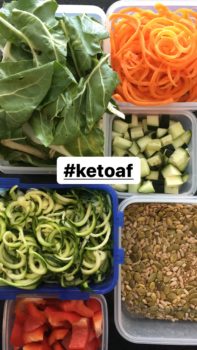 Systems save energy. Especially if the system helps you with something you do every day. This is why I have a system for cooking. When you’re hungry, you make bad decisions, such as grabbing the quickest food you can find – which often happens to be unhealthy food. My cooking system ensures I never have to think about what to eat, or how to prepare it. It frees my time and my mind, so I can focus on creating.
Systems save energy. Especially if the system helps you with something you do every day. This is why I have a system for cooking. When you’re hungry, you make bad decisions, such as grabbing the quickest food you can find – which often happens to be unhealthy food. My cooking system ensures I never have to think about what to eat, or how to prepare it. It frees my time and my mind, so I can focus on creating. Listen to the Podcast
- Listen in iTunes >>
- Download as an MP3 by right-clicking here and choosing “save as.”
- RSS feed for Love Your Work
Three principles of a cooking system
My cooking system is based upon three principles:1. Batch what you can
To batch, prepare what you can beforehand. You save time and energy, and – since many of your ingredients are already ready – you have a healthy meal in no time. As I’ll explain in a bit, in my system, I cut and store vegetables beforehand. This is a little extra work up-front than cutting vegetables before any one meal, but over the course of several meals, it’s less time and hassle. You sometimes have to make compromises for the sake of a system. Pre-cut vegetables are ever-so-slightly less tasty and fresh than vegetables you’ve just cut, but cutting in advance is still a net-positive.2. Never run out
A good system prevents emergencies. After a long day, you don’t want to suddenly discover you have no food, or are missing a crucial ingredient. Even if you had the energy to do so, it would be a waste to run to the grocery store. But you probably don’t have that energy, so you’ll probably order delivery – and that delivery food will not be as healthy as a home-cooked meal would have been, and will cost more. My system is designed to never run out of ingredients. I know the minimum amount of each ingredient I can have before its time to order more. I also know my ingredients won’t go bad because I’ve had them too long. As you use your system, pay attention to just how perishable your regular ingredients are. How long can you keep them? At what minimum supply is it time to order more, so you won’t run out? For example, I have two jars of coconut oil. When I run out of the first, coconut oil goes on my shopping list. I know I’ll buy again before I run out of the second jar.3. Monotony first (variety later)
To start your cooking system, make the same things every single meal. Through repetition, you can gradually sprinkle in variety. Many people think this sounds boring. “I could never do that,” they say. “I could never eat the same thing every meal!” Well, you don’t have to. Eating the same thing every meal is only temporary. It allows you to put together the pieces of your cooking system, such as how often you’ll order ingredients, and what compromises you’re willing to make to have ingredients ready. Making the same things with the same ingredients and the same processes gives you one opportunity after another to optimize your system. When you run out of ingredients or they go bad, you learn how often you need to order. You can also experiment with different processes, and learn how different trade-offs affect the quality of what you cook. Once you have the building blocks of a system in place, you can start adding in variety. Through many iterations of my cooking system, I no longer eat the exact same thing every meal. Many components, such as the vegetables, garnishes, spices, or proteins, can easily be substituted in the same processes to make different dishes. Many people think they couldn’t eat the same thing every meal, but then they continue to do what I used to do: Wait until I was famished, then desperately look for whatever food I could find to shove in my mouth – making bad decisions in the process. If you do this, too, don’t let the perfect be the enemy of the good. You don’t have to eat the same things forever. Try it for a while, then mix in some variety.Categories of ingredients
While you may not want to eat my exact diet, there are categories of ingredients that are nearly universal: protein, vegetables, spices, and garnish. Here’s how those apply to my cooking system.Protein
I eat a variety of meat-based protein sources. I mostly alternate between ground beef and ground pork, but I also occasionally eat ground turkey. My butcher in Colombia has both beef and pork, and packs them into bags of individual serving sizes. I stack them up in my freezer.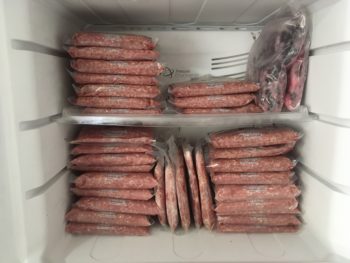 At the end of each day, I take a couple packs from the freezer, and transfer them to the fridge. The packs are thin enough, they’ll be thawed by the next day.
At the end of each day, I take a couple packs from the freezer, and transfer them to the fridge. The packs are thin enough, they’ll be thawed by the next day. Vegetables
The main vegetable in my system is zucchini. I eat a lot of zucchini. My other staple vegetables are carrots, red bell peppers, mushrooms, cucumbers, and celery.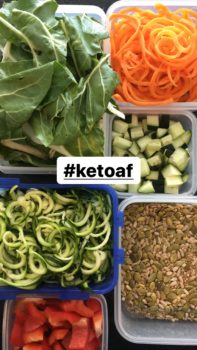 Variability in the sizes of zucchinis has had a big effect on my cooking system. The zucchinis in Colombia are not like Whole Foods, in the U.S., where every zucchini is pretty much the exact same. When I am in the U.S., I can quickly enough make zucchini noodles on-demand with a small handheld spiralizer. But since there’s so much variance in zucchini thickness in Colombia, I use a table-top spiralizer, and store the noodles in a container.
Variability in the sizes of zucchinis has had a big effect on my cooking system. The zucchinis in Colombia are not like Whole Foods, in the U.S., where every zucchini is pretty much the exact same. When I am in the U.S., I can quickly enough make zucchini noodles on-demand with a small handheld spiralizer. But since there’s so much variance in zucchini thickness in Colombia, I use a table-top spiralizer, and store the noodles in a container. 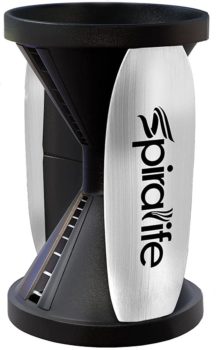
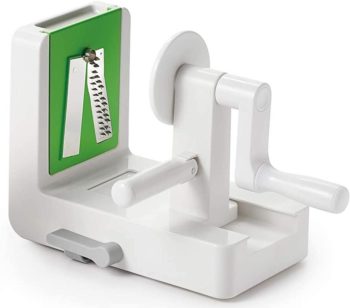 You can also buy pre-cut zucchini noodles at some grocery stores, generally not in Colombia, so I’ll sometimes buy these if they’re available and I’m feeling lazy. Carrots, I spiralize if they’re big enough for the table-top spiralizer. Otherwise, they’re cut down to a small size that can cook quickly. The bell peppers and mushrooms are also cut down to size for cooking. Celery is cut into short sticks for garnish. Cucumbers are cut into half-moons, separated from the seeds for longer storage.
You can also buy pre-cut zucchini noodles at some grocery stores, generally not in Colombia, so I’ll sometimes buy these if they’re available and I’m feeling lazy. Carrots, I spiralize if they’re big enough for the table-top spiralizer. Otherwise, they’re cut down to a small size that can cook quickly. The bell peppers and mushrooms are also cut down to size for cooking. Celery is cut into short sticks for garnish. Cucumbers are cut into half-moons, separated from the seeds for longer storage. Spices
By changing the spices in a dish, you can totally change the flavor. But, I have one go-to spice mix that I make over and over. It’s a taco mix from a keto cookbook, consisting of chili powder, non-sugar sweetener, salt, black pepper, and some other spices. I fill a Tupperware container with the mix every few weeks. Each time I make the mix, I pay attention to my supply of each of those spices, and put on my shopping list any which are low. This way, I never run out of key spices.Garnish
I already mentioned that I garnish my dish with cut celery and cucumber, but I have other things I use in each meal. First, I put on a seed mixture. It’s made of various high-fat seeds: hemp, sunflower, and pumpkin seeds, and sometimes flax seeds. Then, I put on oil. It’s usually coconut oil. Sometimes it’s flax oil. Less often, it’s olive or sunflower oil. My body hates me if I eat a carb, so these seeds and oils help add fat to my dishes, which gives me hard-to-find calories, and helps keep me in ketosis. I also get some extra calories (and fat) by accompanying each meal with avocado. This is as freshly-cut as possible – unless there is some left over from a prior meal. Avocados are just a little too perishable to systematize much, though I’ve gotten better at identifying ripe ones through the avocado challenge I talked about on episode 245.Starches
Honorable mention goes to the starches category. As I said, my body hates carbs, but starches would be a key part of a cooking system for most people. You could use a rice-cooker, and always have hot rice available. Pasta would be a little more work, as it wouldn’t be too good if you didn’t cook it fresh every time. The same probably goes for potatoes or sweet potatoes. Then again, you might be able to make all these starches in a rice cooker, which could save a lot of time.My cooking process
Now that I’ve talked about the principles and categories of my cooking system, here’s the process I follow. As I talk about some of the decisions I’ve made in this system, you’ll get an idea of how you can build your own system.Step 1: Begin cooking protein
To begin, I start the burner and put the pan on the stove. I pull a bag of meat out of the fridge, slice it open, and put the meat on the pan. I then put some of my spice mix on the meat, turn it over, and turn up the heat a bit. I want to burn some of the spices onto the ground meat, for extra flavor.Step 2: Take out other ingredients
Through repetition, I’ve figured out the exact order to do each step in my system. Notice that I started the burner first. That gives it a little time to heat up, while I’m removing the meat and unpacking it to cook. It takes time to take so many containers of ingredients out of the fridge, so I do that after I’ve started cooking the meat.Step 3: Begin cooking “round 1” vegetables
I could add all my vegetables at the same time, but then they wouldn’t each be optimally cooked. So, I take the extra effort to add my vegetables in “rounds,” based upon how long they will take to cook. At this point, I add my “round 1” vegetables: mushrooms, and if my carrots are sliced and not spiralized, I’ll also add them. Otherwise, they get added later, which I’ll explain in a later step.Step 4: Prepare plate with garnishes
While the meat and first round of vegetables are cooking, I prepare the plate, with garnishes. I take a plate out of the cabinet, and add some celery and cucumber to the edge of the plate.Step 5: Break up protein, and add “round 2” vegetables
Now that the meat and round 1 vegetables have cooked a bit – while I prepared the plate – I break up the ground meat, and stir it up with the vegetables. I then add the “round 2” vegetables, which is usually just sliced up red bell peppers.Step 6: Cut avocado
While the red bell peppers are cooking, I cut an avocado, and add half of it to the plate as garnish.Step 7: Add “round 3” vegetables
Finally, I add the “round 3” vegetables. This is my zucchini noodles and – if the carrots were large enough to make noodles – my carrot noodles. Since carrots and zucchinis are of different consistencies, the carrot noodles are sliced thinner than the zucchini noodles. This way, I can add both at the same time, and they will both cook to the right point, in parallel. I’ve been cooking without a cover on the pan this whole time (otherwise the dish would get too watery). But at this point, I cover it, so the noodles get steamed by the trapped moisture.Step 8: Serve
Within a couple minutes, the round 3 vegetables have steamed, and all the other ingredients have cooked to their perfect points in the meantime. While that was happening, I’ve put a glass of water on the table, and grabbed a fork. I’ve gotten a measuring spoon and my seed mixture ready, and I’ve gotten the oils ready, too. I serve the entire contents of the pan onto my plate, add my seeds and oils, and I’m ready to eat.Clean up
Clean up after this is easy, because I do this all in a single pan. I’m mindful of health effects of my cooking materials, and it seems every one is potentially problematic: Teflon is toxic; once aluminum is in your body, you can’t get it out; ceramic-coated cookware doesn’t last; and materials that are already in our diets, such as copper or iron, may impart too much of those substances into your food. That leaves stainless steel, but then you’re eating nickel. Thus, I use a “21/0”, nickel-free stainless steel pan. This could be the wrong choice for some reason I’m not aware of, but I’m trying.“But I like grocery shopping/cooking”
Many people object to this cooking system, saying they actually like grocery shopping, so don’t want to do less of it, and that they actually like cooking. You don’t have to cut down on anything you don’t like to follow a system – just design your system accordingly. This is my default meal, and I can always make it when I want to use my time and energy thinking about something else – such as writing my next book. But, I sometimes make a new recipe, and I have a grab-bag of other recipes I make if and when I want variety – which turns out is not terribly often. When friends hear about my system, they often ask what my partner thinks of it. She actually loves it. I left her out of my description of the process, but when we make this together for dinner, we’re like poetry in motion – our moves are perfectly coordinated, with me cooking things as she cuts vegetables or takes containers out of the fridge. She has grown to like it so much that when I’m not in town, she follows the same system.Start your cooking system
Hopefully this gets you thinking about how the processes you follow affect how you use your time and energy, and the decisions you make about what to eat. (A special thanks to Nelson Quest, who once made a YouTube video that no longer exists, which inspired this system.)Mind Management, Not Time Management now in hardcover!
Mind Management, Not Time Management has now sold 10,000 copies! Order your hardcover “souvenir” from Amazon, Barnes & Noble, or your favorite bookstore.Join the Patreon for (new) bonus content!
I've been adding lots of new content to Patreon. Join the Patreon »
Subscribe to Love Your Work
Listen to the Podcast
- Listen in iTunes >>
- Download as an MP3 by right-clicking here and choosing “save as.”
- RSS feed for Love Your Work
Theme music: Dorena “At Sea”, from the album About Everything And More. By Arrangement with Deep Elm Records. Listen on Spotify »



